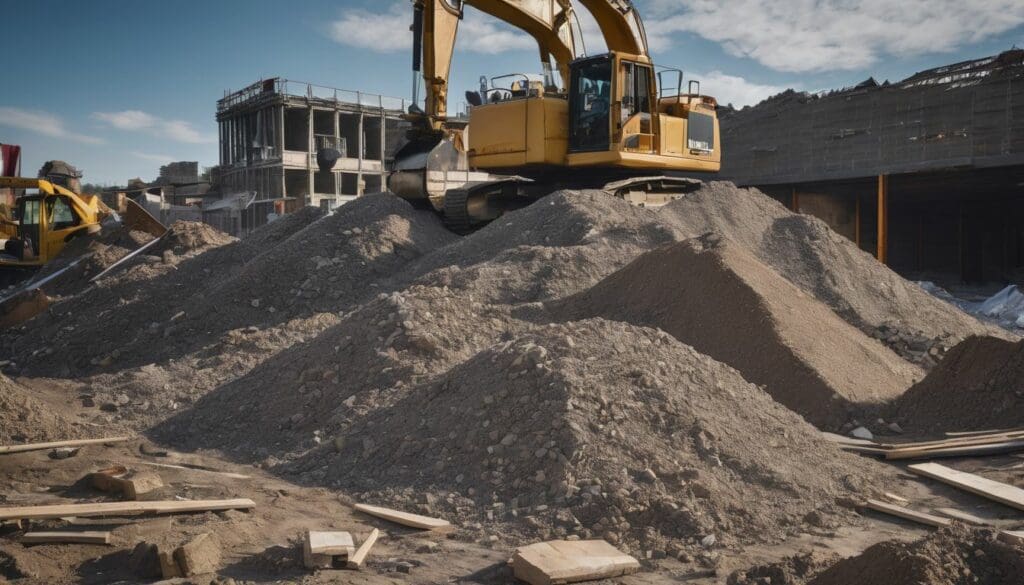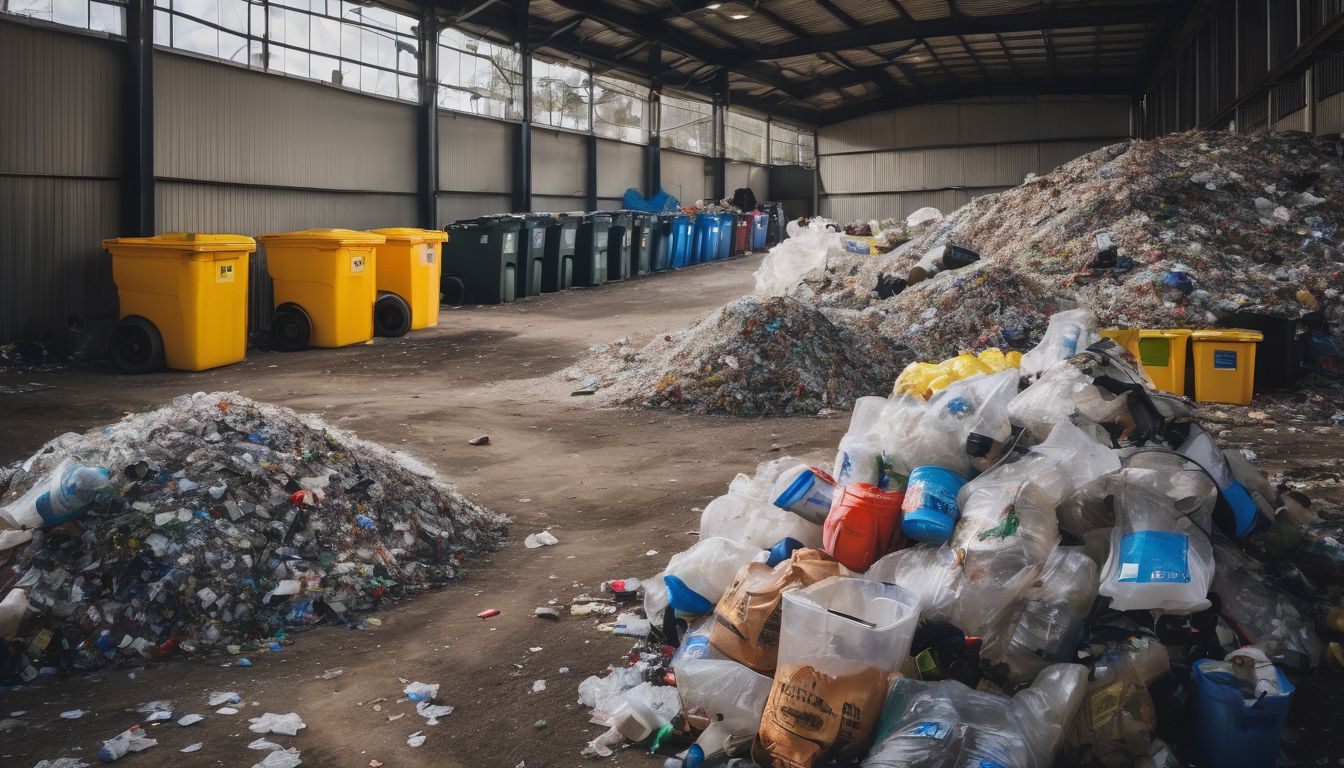Building sustainably is vital in our quest to protect the planet, yet construction and demolition (C&D) waste continues to climb. Astonishingly, C&D activities contribute to a significant portion of total solid waste generated worldwide each year.
This article is your guide to understanding how recycling plays a crucial role in transforming the construction industry into a more sustainable one. Discover ways to build for tomorrow without harming today’s environment.
Key Takeaways
- Recycling in construction reduces the volume of waste that ends up in landfills, conserving space and preventing environmental pollution.
- By using recycled materials like concrete and metal, builders can cut down on energy use and carbon emissions linked to producing new building supplies.
- Sustainable construction practices save money by reducing the need for purchasing new materials and cutting disposal fees for waste.
- Choosing recycled products encourages manufacturers to create eco – friendly alternatives, supporting a market shift towards sustainable building components.
- Practicing recycling in building projects shows a commitment to social responsibility by preserving resources for future generations and minimising negative impacts on the environment.
Understanding C&D Materials
C&D materials refer to construction and demolition waste, which includes concrete, wood, metals, bricks, and more. These materials have a significant impact on the environment due to their volume and composition.
Definition of C&D materials
C&D materials are the remnants from construction, deconstruction, or demolition sites. They include a vast array of substances such as concrete, bricks, wood, glass, metals and plastics.
Each piece can have a second life if handled correctly in the recycling process which supports global environmental sustainability.
Often overlooked by traditional building practices, C&D waste carries significant weight in conversations about resource conservation and eco-friendly construction strategies. Proper management of these materials creates a circular economy where recycled items return to usage instead of clogging landfills and harming aquatic ecosystems.
This approach highlights the necessity for sustainable materials that pave the way towards green construction initiatives.
Common types of C&D materials
- Concrete: This comprises concrete slabs, beams, columns, and other rubble produced during demolition or construction activities.
- Wood: This category includes lumber, plywood, and timber created from building structures and fixtures.
- Metals: C&D materials encompass various metals such as steel, copper, and aluminium obtained from structural elements like framing and wiring.
- Plastics: Construction plastics include pipes, windows, doors, and other synthetic materials discarded after their use.
- Bricks: Bricks are a common C&D material that results from the demolition of brick structures or excess production.
- Glass: Building glass from windows, doors, facades, or partitions is considered a significant C&D waste product.
- Asphalt: This type of material originates from road surfaces or asphalt roofing shingles during renovations or repairs.
The impact of C&D materials on the environment
C&D materials significantly impact the environment, contributing to pollution and resource depletion. These materials, such as concrete, wood, and metals, create large amounts of waste during construction and demolition activities.
This waste ends up in landfills, taking up space and releasing harmful substances into the soil and water. Additionally, producing new C&D materials requires energy and resources leading to increased carbon emissions.
Recycling C&D materials can mitigate these adverse effects by reducing the demand for virgin resources and lowering pollution levels. Reusing concrete or metal reduces the need for new production processes with heavy environmental footprints.
Benefits of Reducing the Disposal of C&D Materials
Reducing the disposal of C&D materials benefits the environment by decreasing waste and conserving resources. This also leads to cost-effectiveness in construction projects.
Reduction of waste
Construction and demolition (C&D) materials account for a significant portion of waste in the construction industry. Minimising waste through efficient management practices such as source reduction, salvaging, reusing, and recycling can contribute to resource efficiency and environmental conservation.
By diverting materials from landfills and incineration, we can reduce the environmental impact while also creating cost-effective solutions for sustainable construction. Embracing waste reduction strategies not only supports eco-friendly building practices but also aligns with social responsibility by minimising our carbon footprint.
Implementing recycling initiatives within the construction sector allows us to repurpose valuable resources like metal, concrete, timber, and glass, contributing to the circular economy.
Choosing to recycle C&D materials rather than disposing of them offers long-term benefits by preserving natural resources and promoting sustainable development in the built environment.
Conservation of resources
To conserve resources, construction companies can implement waste reduction strategies such as salvaging and reusing materials, and recycling items like metal, concrete, and wood. By diverting these materials from landfills into recycling facilities instead, they can help to preserve natural resources and reduce the need for new material extraction.
This not only conserves raw materials but also reduces energy consumption and greenhouse gas emissions associated with manufacturing new products.
Through sustainable practices like material reuse and recycling in construction projects, we can collectively contribute towards minimising our impact on the environment while promoting a more circular economy.
Cost-effectiveness
Using recycled materials in construction can be cost-effective and help in managing the budget. The use of reclaimed materials and recycled metal reduces the need to purchase new resources, leading to lower costs for building projects.
Additionally, recycling C&D materials decreases disposal fees and can result in financial savings for construction companies.
By focusing on cost-effectiveness through recycling, sustainable construction practices are encouraged while also supporting economic goals. Emphasising the financial benefits of using recycled materials contributes positively to both environmental conservation and business sustainability.
Strategies for Reducing the Use of C&D Materials
Implementing source reduction, salvaging and reusing materials, recycling materials, and rebuying materials are key strategies to reduce the use of construction and demolition materials.
Learn more about how these sustainable practices contribute to environmentally friendly construction.
Source reduction
Source reduction involves minimising the amount of waste produced by considering alternative designs, materials, or systems. By choosing durable and long-lasting construction materials and opting for efficient design techniques, builders can reduce the overall environmental impact of a project.
This approach not only conserves resources but also lowers disposal costs and reduces the need for new raw materials, contributing to a more sustainable construction industry.
Implementing source reduction strategies such as modular construction and prefabrication can significantly decrease the amount of waste generated during building projects. Additionally, adopting innovative technologies that promote material efficiency and reusability further supports eco-friendly practices in construction.
Salvaging and reusing materials
When minimising waste through source reduction isn’t feasible, salvaging and reusing materials becomes essential in sustainable construction. Salvaging and reusing building materials not only reduces the demand for new resources but also minimises the environmental impact associated with manufacturing and transportation.
This practice helps in conserving energy and natural resources while promoting a circular economy by extending the lifespan of materials. By salvaging and reusing materials such as wood, bricks, metals, or fixtures from demolition sites or renovated buildings, construction projects can significantly reduce their carbon footprint and contribute to a more eco-friendly approach to building.
The process of salvaging and reusing materials requires careful planning to ensure that the materials are suitable for reuse without compromising structural integrity. Certification bodies play a crucial role in verifying the quality of salvaged building components to maintain safety standards.
Recycling materials
After salvaging and reusing materials, another important strategy for reducing the use of C&D materials is recycling. Recycling building materials such as concrete, wood, and metal helps to conserve natural resources and reduce the environmental impact of construction projects.
By repurposing these materials into new products or incorporating them back into the construction process, builders can significantly decrease waste going to landfills while promoting a more sustainable approach to construction.
Additionally, recycling materials plays a crucial role in eco-friendly construction practices by minimising the need for extracting raw resources and decreasing energy consumption associated with manufacturing new building materials.
Rebuying materials
When reducing and reusing materials, rebuying recycled products plays a crucial role in sustainable construction. By choosing to purchase recycled content materials, individuals support the demand for reused resources, driving the market towards eco-friendly alternatives.
This encourages manufacturers to prioritise sustainable practices and reduces the need for new raw materials, ultimately contributing to waste reduction and conservation of resources.
Opting to rebuy materials made from recycled content not only helps in minimising environmental impact but also promotes a circular economy within the construction industry. This reinforces the concept of sustainability by closing the loop on material use and extending their lifespan, aligning with environmentally conscious values.
The Importance of Sustainable Construction Practices
Sustainable construction practices play a crucial role in reducing environmental impact, promoting economic benefits, and fulfilling social responsibility. By incorporating eco-friendly materials and waste management strategies, sustainable construction can contribute to a healthier planet and more efficient use of resources.
Environmental impact
Sustainable construction practices have a significant environmental impact, reducing the extraction of raw materials and lessening the burden on landfills. Choosing recycled materials over virgin resources lowers energy consumption and greenhouse gas emissions, contributing to a healthier planet for future generations.
Sustainable construction also minimises water and air pollution, safeguarding ecosystems and wildlife habitats, preserving biodiversity for a more balanced and sustainable natural environment.
Implementing eco-friendly construction methods is vital for mitigating the negative effects of traditional building practices. By prioritising recycling in sustainable construction, individuals can actively participate in protecting the environment while fostering a more sustainable future.
Economic benefits
Moving on from the environmental impact, it’s important to consider the economic benefits of sustainable construction practices. By reducing the disposal of construction and demolition materials through recycling, companies can significantly cut down on waste management costs.
Reusing and repurposing materials not only saves money but also reduces the need for raw resources, resulting in long-term cost-effectiveness.
Furthermore, embracing eco-friendly construction practices can lead to financial incentives such as tax credits or grants for implementing sustainable solutions. The efficient use of recycled materials and reduced energy consumption contribute to lower operational expenses, making sustainable construction a financially viable choice for businesses and communities alike.
Social responsibility
Construction companies and individuals involved in sustainable construction practices have a social responsibility to manage their demolition and construction waste effectively. By prioritising the reduction, reuse, and recycling of materials, they contribute to the conservation of resources and minimisation of environmental impact.
Embracing eco-friendly construction methods not only benefits the present generation but also ensures a healthier environment for future generations, aligning with the values of socially responsible citizens who prioritise environmental sustainability.
Embracing sustainable construction practices is an expression of social responsibility that resonates with environmentally conscious individuals who understand the importance of minimising waste and preserving natural resources.
Conclusion
In conclusion, recycling plays a crucial role in sustainable construction by reducing the disposal of C&D materials. It helps conserve resources, reduces waste, and promotes eco-friendly practices.
Embracing recycling in construction contributes to environmental preservation while also promoting cost-effectiveness and social responsibility. By integrating recycling into construction practices, we can build a more sustainable future for generations to come.
FAQs
1. Why is recycling important in sustainable construction?
Recycling plays a crucial role in sustainable construction by reducing demolition and construction waste, which helps manage resources more efficiently for ecofriendly building practices.
2. How can we manage construction waste effectively?
Effective management of construction waste involves sorting materials to reuse and repurpose them, thereby cutting down the amount of rubbish generated during building projects.
3. What does certification for sustainable construction mean?
Certification for sustainable construction means a project has met certain standards that focus on environmentally responsible and resource-efficient processes throughout a building’s life cycle.
4. Are there ways to reduce waste before starting a new build?
Yes, planning ahead with an emphasis on reusing materials from previous structures can significantly contribute to construction waste reduction, lining up with sustainability goals.





